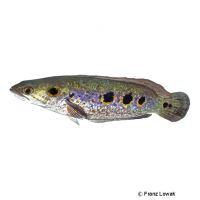Ocellated Snakehead (Channa pleurophthalma)
| Ocellated Snakehead Channa pleurophthalma | |
|---|---|
| Name | Ocellated Snakehead |
| Name Lat. | Channa pleurophthalma |
| Family | Snakeheads |
| Family lat. | Channidae |
| Order | Labyrinth Fishes |
| Order lat. | Anabantiformes |
| Origin | Southeast Asia |
| Habitat | Rivers, floodplains |
| Diet | Carnivore |
| pH | 6.5-7.5 |
| Behavior | Predatory |
| Keeping | Individual, pair |
| Care Level | Difficult |
| Reproduction | Egg scatterer |
| Breeding | None reported |
| Life Span | 8-12 years |
| Protection | No |
| Metric Units | |
| Size | 30-40 cm |
| Temperature | 26-28 °C |
| Hardness | 5-15 °dH |
| Aquarium | 150 cm / 370 l |
| US Units | |
| Size | 12"-16" |
| Temperature | 79-82 °F |
| Hardness | 89-267 ppm |
| Aquarium | 100 gal |
Distribution and habitat
The distribution area of the eye spot snakehead fish is in the southeast of the island of Sumatra and in the west of the island of Borneo (Kalimantan). They live in the current of clear rivers and streams with oxygen-rich water.
Maintenance
The aquarium should have marginal planting, with some hiding places such as caves (e.g. perforated rocks, tubes) and roots, and plenty of free swimming space. A dark sand substrate covered with some foliage (e.g. sea almond or beech leaves) and subdued light, as well as oxygen-rich water with strong surface current is ideal.
No ammonia, ammonium or nitrite should be detectable, and the nitrate value should not exceed 100 mg/l. To ensure the water quality and oxygen content, a filter and heater adapted to the aquarium size is required, as well as lighting for the species-appropriate day-night rhythm of the animals.
Diet
They are voracious predators. According to their size, the food offer consists of insect larvae, shrimps, mysis, small crustaceans, crab meat and fish, which is also accepted frozen without problems or a commercial frozen food mix, supplemented with live earthworms fly maggots, etc. Dry food (granules, sticks) is occasionally accepted, but should not be the main food.
Only feed as much as will be eaten immediately (in 10 minutes maximum). Regular and varied feeding promotes health and avoids deficiency symptoms
Behaviour and compatibility
Juveniles are compatible with each other, adults are aggressive within the species. In a tank with many hiding places a pair keeping is possible. Once a pair has been found, they usually stay together for life. They can be socialized with calm, large fish that they do not consider prey, such as shark barbs.
In principle, only mutually compatible fish species with similar requirements for water conditions and water temperature should be socialized.
Sex dimorphism
No distinguishing characteristics are known. Presumably the females are somewhat larger and rounder, especially at spawning time.
Reproduction and breeding
There is no detailed information about the reproduction of the Eye Spot Snakeheads. Presumably they are, like most snakeheads, free spawners and practice brood care
There are no known reports about successful breeding in the aquarium.
Important
Especially juvenile animals need very oxygen-rich water.
The fish should not be offered meat from mammals (beef, pork) or poultry, as it contains certain lipids that cannot be digested and therefore fat deposits and even organ degeneration can occur.
They have an additional respiratory organ, the so-called labyrinth (suprabranchial organ) with which they breathe atmospheric air and can suffocate if this is not possible
Since they like to jump, the aquarium must be well covered.
The well-being of the fish should be checked regularly. Temperature should be checked daily, pH, hardness and nitrate levels at least every 14 days. Regular partial water changes are recommended, even if the contaminant level has not yet reached the upper limit. Sudden changes in water quality should be avoided. Newly introduced fish must be accustomed slowly to the water in the aquarium.
Further literature can be found in your pet store.
References
Text: Werner Winter; Image: Franz Lowak
Source: BMELV (1998): Tierschutzgutachten - Haltung von Zierfischen (Süßwasser); ENGELMANN (2005): Zootierhaltung - Tiere in menschlicher Obhut: Fische, Verlag Harri Deutsch
- Gemäß § 21 Abs. 5 Tierschutzgesetz idgF
